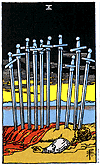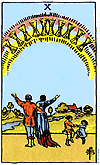Seeing Both Sides of the Card
We have already seen that the cards are magically and morally neutral - so
important is this fact that I made it my First Principle of Tarot. A logical
extension of this fact - one which is often overlooked - is that the meanings
of the cards are essentially neutral as well. Contrary to what some might
assert, there are no inherently "negative" or "positive" cards. Another of
my Principles states that the Tarot evolves to suit the people who use it,
and a necessary condition for such evolution is that all of the cards, from
the brightest of the Cups to the darkest of the Swords, contain the seeds of
both light and dark, positive and negative.
This fact may not seem immediately obvious. After all, how can one find any
negative aspects of such cards as the Nine of Cups, or The Sun? Similarly,
how can one find anything good in The Tower, or in the Three of Swords? It
is not only possible to do so, but learning how to see both sides of every
card is essential to understanding the cards, and to giving good readings.
Let's face it - eventually, Ten of Swords is going to show up in the "best
outcome" position of a spread, and it will be necessary for you to see the
brighter side of this supposedly dark and gloomy card. That, or the Ten of
Cups will appear in a "things to avoid" position which will require you to
see the shadow produced by this card's normally uplifting message.

 The Ten of Swords and Ten of Cups are such a good examples that I will use
them to demonstrate the technique of "seeing both sides of the card". By
examining the imagery of these cards it becomes possible to see some of
their overlooked aspects. How can anything be good about a man impaled by
ten swords? What wrong can be found in a family celebrating under a rainbow?
To find out we have to consider a half-dozen features of the card. This
procedure can be repeated to find the good parts of any so-called "negative"
card, or the darker sides of the "positive" cards.
The Ten of Swords and Ten of Cups are such a good examples that I will use
them to demonstrate the technique of "seeing both sides of the card". By
examining the imagery of these cards it becomes possible to see some of
their overlooked aspects. How can anything be good about a man impaled by
ten swords? What wrong can be found in a family celebrating under a rainbow?
To find out we have to consider a half-dozen features of the card. This
procedure can be repeated to find the good parts of any so-called "negative"
card, or the darker sides of the "positive" cards.
- Pay attention to detail. The same details that divulge a card's true
meaning will let you see the light hidden beneath a shadow.
- Think about what should be present in the scene, but is absent, and think
about why that particular thing is missing.
- Also consider what parts of the image shouldn't be there, but which are
present, and why they are included.
- Consider any "repeating symbols" that link cards together, such as the
river, the mountains, red-on-white, etc. What does their presence imply?
- In the case of Minor Arcana, consider their number and which Major(s) this
links them to.
Here is what this process reveals about the "negative" Ten of Swords:
- Look at the man's left hand. Compare with the left hand of the Hierophant
and you'll see that it's the same gesture. This suggests that, though the
man is in physical pain, he has been spiritually enlightened.
- Though the man has been impaled with ten swords, there is no blood coming
out of any of his wounds. This implies that he is not really hurt at all;
perhaps the swords are only there in his mind.
- Why is the background of this "doom and gloom" card adorned with the
radiant golden glow of a rising sun? Because the night is over and now
the day is here. The associated meaning is that bad things will pass.
- The mountains in the background are often associated with spiritual
enlightenment, and this reinforces the "hand gesture" noted above.
- The Ten of Swords has connections to the Wheel of Fortune and the Sun,
both of which illustrate the kind of turnaround symbolized by the rising
sun in the background.
Just to show that similar techniques can apply to "positive" cards, I will
use a similar analysis on the Ten of Cups - a card almost universally seen
as full of happiness and light. But:
- The colors on the rainbow are clearly mixed up - look at any real rainbow
and you'll see yellow in the middle and blue on the bottom. This implies
that what the people are seeing may not be a real rainbow after all.
- What I think should be present on a card symbolizing joy and unity is a
single group of four - not two groups of two. The parents are happy and
the children are happy but each is ignoring the other. This is also a
"separation" card; perhaps this family is not as close as it would seem.
- The fact that the Cups are floating on the rainbow, out of reach of the
people below, suggests to me that the true happiness they seek is just
outside their grasp. Perhaps the outstretched arms of the parents are
not signs of joy but signs of longing for what they know will never be.
- A river flows through the card, and this same river appears on cards like
The Moon and Death - cards which represent illusion and change. Not only
is this fantasy fragile, but it may pass away soon.
- Like the Ten of Swords, the Ten of Cups links back to the Sun (which,
though it has no real detrimental effect, is elementally opposite) and
to the Wheel of Fortune, another harbinger of change and instability.
So what has this process proven? Is the Ten of Swords a card of ruin or of
spiritual enlightenment? Does the Ten of Cups represent real happiness or
just an idealistic daydream? The answer is that the cards can represent both
of these meanings, depending on the situation. They are inherently neutral
but they can cover a full range of meanings, from the very positive to the
very negative.
Learning to work within this range is essential to a true understanding of
the Tarot - not just of those cards which most readers do not touch with a
ten-foot pole, but also of those with whom they feel totally comfortable.
Eventually you will come to see that the friendliest cards can sometimes be
used to stab you in the back, and that the darkest ones can often turn out
to be your best friends.
Copyright 2000 James Rioux

 The Ten of Swords and Ten of Cups are such a good examples that I will use
them to demonstrate the technique of "seeing both sides of the card". By
examining the imagery of these cards it becomes possible to see some of
their overlooked aspects. How can anything be good about a man impaled by
ten swords? What wrong can be found in a family celebrating under a rainbow?
To find out we have to consider a half-dozen features of the card. This
procedure can be repeated to find the good parts of any so-called "negative"
card, or the darker sides of the "positive" cards.
The Ten of Swords and Ten of Cups are such a good examples that I will use
them to demonstrate the technique of "seeing both sides of the card". By
examining the imagery of these cards it becomes possible to see some of
their overlooked aspects. How can anything be good about a man impaled by
ten swords? What wrong can be found in a family celebrating under a rainbow?
To find out we have to consider a half-dozen features of the card. This
procedure can be repeated to find the good parts of any so-called "negative"
card, or the darker sides of the "positive" cards.